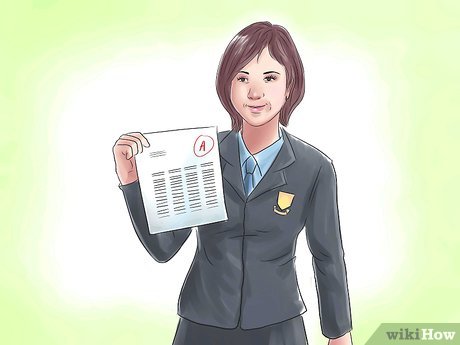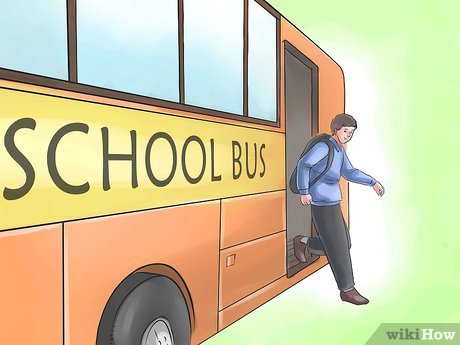How to Choose a School
Choosing a school can be a very stressful experience. Parents and kids alike have deep worries about finding a place where the children will be healthy, happy, and be prepared for a bright future. Here is how you can find a great school!...
Part 1 of 4:
Researching the Academics
-
 Get the test scores. Test scores are not the whole picture, but many parents will start out there.
Get the test scores. Test scores are not the whole picture, but many parents will start out there.- Determine the online source for school rankings. It is different in different states and countries, but you will find it if you search online for "school rankings for your location."
- For example, in California, USA, every school has its ranking by test score listed on California Department of Education website.[1] . In the UK, you can find these rankings at Ofsted.[2] You can also find more subjective ratings on other websites like GreatSchools and many others.
-
 Know that test scores don't tell the whole story. There are many factors that influence test scores, and not all of these truly indicate the quality of the overall learning experience or the experience your child will have.
Know that test scores don't tell the whole story. There are many factors that influence test scores, and not all of these truly indicate the quality of the overall learning experience or the experience your child will have.- Wealthier areas have parents that can afford coaches and tutors, so if you find a school in a poorer area that is above average for its income level, you may have a real winner.
- Note that test scores are typically reported by school. There will be test score variation by teacher, and by set of students.
- Getting a teacher at a school is sort of like getting a lawyer from a law firm. It doesn't matter if the law firm is the top one if they give you their worst lawyer.
-
 Visit the website of the school. If their school has won awards for excellence, you can bet those will be listed.
Visit the website of the school. If their school has won awards for excellence, you can bet those will be listed. -
 Ensure the school offers the classes your child wants. Larger schools are more likely to have a diversity of classes offered.
Ensure the school offers the classes your child wants. Larger schools are more likely to have a diversity of classes offered.- Also ask about other electives/extracurriculars. Find out if the school offers the non academic things you might be looking for, such as band, sports, debate, theater. Ask students who study in that school about its role in their lives i.e. are they motivated in other activities besides studies.
Part 2 of 4:
Understanding the Environment
-
 Talk to others. Find parents and children that are currently at the school and talk with them about their experiences. You should be able to find people to talk to you in most cases, by friends of friends or just online.
Talk to others. Find parents and children that are currently at the school and talk with them about their experiences. You should be able to find people to talk to you in most cases, by friends of friends or just online.- If you are far away, you can ask the school for references. If they did not want to help you, that is probably a bad sign.
-
 Get a tour of the school. Simply visit the school's website to inquire about tours. Almost any school will allow prospective parents and students to visit, if they simply ask.
Get a tour of the school. Simply visit the school's website to inquire about tours. Almost any school will allow prospective parents and students to visit, if they simply ask.- Tours can be for both parents and children. Most times, parents would want the child to see the school as well.
- Many schools will also have the opportunity for a child to visit an actual classroom, which is very helpful.
- Make sure you see lunch and recess time. Ensure non classroom time has adequate supervision and the kids look happy. Non supervised time on a playground is a big stress factor for many children.
-
 Ask about teacher credentials, experience, and turnover rate. These factors are not necessarily good or bad, but can inform your decision.
Ask about teacher credentials, experience, and turnover rate. These factors are not necessarily good or bad, but can inform your decision.- Credentials are not always important; many of the best teachers at private schools do not have them. Experience in class management matters even more than qualification.
- A high turnover rate of teachers is rarely a good thing.
- Experience in teachers is usually good, but some experienced tenured teachers are not engaged. Similarly, a lot of young teachers is not necessarily good or bad; some are very enthusiastic and energetic, others inexperienced and not good at classroom management.
-
 Know if there are any accommodations for any special needs your child may have. Special needs parent groups - online or offline - can be useful.
Know if there are any accommodations for any special needs your child may have. Special needs parent groups - online or offline - can be useful.- Most places require schools to accommodate special needs. But not all are eager or willing.
- Gifted children also can require special accommodations.
-
 Some parents seek out particular programs for their children. Parents may look for STEM (science, technology, engineering and math) focused schools, language immersion schools, and others.
Some parents seek out particular programs for their children. Parents may look for STEM (science, technology, engineering and math) focused schools, language immersion schools, and others.
Part 3 of 4:
Knowing the Neighborhood and Transportation
-
 Make sure your child will be safe at school. You can rule schools out by neighborhood. A great school may not be great for your child, if the school is dangerous. Others may be too far from your house, or not have good transportation.
Make sure your child will be safe at school. You can rule schools out by neighborhood. A great school may not be great for your child, if the school is dangerous. Others may be too far from your house, or not have good transportation. -
 Walk around the school. Try to get a feel for the overall campus environment. Is it clean? Well maintained? Does it feel safe?
Walk around the school. Try to get a feel for the overall campus environment. Is it clean? Well maintained? Does it feel safe?- Stop by the school office to get a pass to come on campus, or arrange a tour.
- Many schools do not allow people to come onto school property unannounced while school is in session, for security reasons. This does not mean they have something to hide.
-
 Check transportation options. Make sure transportation to and from school is convenient and safe.
Check transportation options. Make sure transportation to and from school is convenient and safe.- If transport to the school is by bus, take the bus to school during commute time. Buses can be dangerous, or just very rowdy. By experiencing, you will feel and know what it will be like.
- If transport by car, go by the school during drop off hours to ensure it is doable for you.
- If transport is by foot or bicycle, ensure there are good safety precautions, such as walkways or bicycle paths.
Part 4 of 4:
Enrolling in the School
-
 Once you have decided on a school, you can attempt to enroll. Most schools offer both online registration and in person registration.
Once you have decided on a school, you can attempt to enroll. Most schools offer both online registration and in person registration.- See the instructions for the things you will need to enroll. Many local schools will require proof that you live in the area of the school. Elite schools, may require more detailed applications and/or aptitude tests.
- In the USA, publicly funded schools are not allowed to choose which students they can accept, but they instead have regulations for how they choose when they have limited space.
- If you do not live in the area of the school, you may have different or special instructions.
-
 Find if the school you want has space available for new students. Some schools will take new students any time. Others do not have space.
Find if the school you want has space available for new students. Some schools will take new students any time. Others do not have space.- If the school has limited space available, read up on when enrollment starts. You will want to be first in line, or first online during the registration period for best chances.
- If your child has any special needs, consider if you want to discuss them with the school when applying. In some cases, you want to ensure the special needs will be met before applying. In other cases, you may not want to disclose; the school may be required to provide services that are expensive.
4 ★ | 1 Vote
You should read it
- How to Choose a Good School (for Parents)
- How to Prepare Your Child for Middle School
- How to Transfer an IEP to Another School
- How to Choose Between Private and Public School
- How to Blog Respectfully About Your Disabled Child
- How to use the most simple, detailed child locator Q50
- How to Report a School for Discriminatory Discipline
- How to Communicate with a Child's Middle School Teacher
- Things parents should not do for their children
- The 'mouthful' statements of parents accidentally depress the child
- How to Understand the Benefits of All Girls Schools
- 3 most used basketball cylinders in school


















 How to Choose a Good School (for Parents)
How to Choose a Good School (for Parents) The app helps you choose a career, choose a school and know the salary
The app helps you choose a career, choose a school and know the salary Select the appropriate field with a score of 22 to 27
Select the appropriate field with a score of 22 to 27 Choose Core i3 laptop priced from 7 million VND for the new school year
Choose Core i3 laptop priced from 7 million VND for the new school year Choose a laptop for the new school year - You know how?
Choose a laptop for the new school year - You know how? So choose a computer, laptop how to fit?
So choose a computer, laptop how to fit?